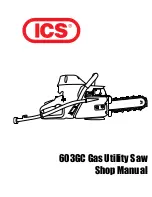
5
ENGLISH
(Original instructions)
•
Keep your body positioned to either side of the blade, but not in line with the saw blade.
KICKBACK could cause the saw to jump backwards (see
Causes and Operator Prevention of
Kickback and KICKBACK)
.
•
Avoid cutting nails. Inspect for and remove all nails from lumber before cutting.
•
Always make sure nothing interferes with the movement of the lower blade guard.
•
Accessories must be rated for at least the speed recommended on the tool warning
label.
Wheels and other accessories running over rated speed can fly apart and cause injury.
Accessory ratings must always be above tool speed as shown on tool nameplate.
•
Always make sure the saw is clean before using.
•
Stop using this saw and have it properly serviced if any unusual noise or abnormal operation occurs.
•
Always be sure all components are mounted properly and securely before using tool.
•
Always handle the saw blade with care when mounting or removing it or when removing the
diamond knockout.
•
Always wait until the motor has reached full speed before starting a cut.
•
Always keep handles dry, clean and free of oil and grease. Hold the tool firmly with both hands
when in use.
•
Always be alert at all times, especially during repetitive, monotonous operations. Always be sure
of position of your hands relative to the blade.
•
Stay clear of end pieces that may fall after cutting off. They may be hot, sharp and/or heavy.
Serious personal injury may result.
•
Replace or repair damaged cords. Make sure your extension cord is in good condition. Use
only 3-wire extension cords that have 3-prong grounding-type plugs and 3-pole receptacles that
accept the tool’s plug
.
•
An extension cord must have adequate wire size (AWG or American Wire Gauge) for safety.
The smaller the gauge number of the wire, the greater the capacity of the cable, that is 16 gauge
has more capacity than 18 gauge. An undersized cord will cause a drop in line voltage resulting in
loss of power and overheating. When using more than one extension to make up the total length, be
sure each individual extension contains at least the minimum wire size. The following table shows the
correct size to use depending on cord length and nameplate ampere rating. If in doubt, use the next
heavier gauge. The smaller the gauge number, the heavier the cord.
CAUTION:
Blades coast after turn off. Serious personal injury may result.
WARNING:
AlWAyS wear proper personal hearing protection that conforms to ANSI
S12.6 (S3.19) during use.
Under some conditions and duration of use, noise from this product may
contribute to hearing loss.
WARNING:
AlWAyS use proper eye protection.
All users and bystanders must wear proper
eye protection that conforms to ANSI Z87.1.
WARNING:
AlWAyS USE SAFETy GlASSES.
Everyday eyeglasses are NOT safety glasses.
Also use face or dust mask if cutting operation is dusty. ALWAYS wear certified safety equipment:
•
ANSI Z87.1 eye protection (CAN/CPA Z94.3),
•
ANSI S12.6 (S3.19) hearing protection,
•
NOSH/OSHA respiratory protection.
WARNING:
Some dust created by power sanding, sawing, grinding, drilling, and other
construction activities contains chemicals known to the state of California to cause cancer,
birth defects or other reproductive harm. Some examples of these chemicals are:
•
lead from lead-based paints,
•
crystalline silica from bricks and cement and other masonry products, and
•
arsenic and chromium from chemically-treated lumber.
Your risk from these exposures varies, depending on how often you do this type of work. To reduce
your exposure to these chemicals: work in a well ventilated area, and work with approved safety
equipment, such as those dust masks that are specially designed to filter out microscopic particles.
•
Avoid prolonged contact with dust from power sanding, sawing, grinding, drilling, and other
construction activities. Wear protective clothing and wash exposed areas with soap and water.
Allowing dust to get into your mouth, eyes, or lay on the skin may promote absorption of harmful chemicals.






























